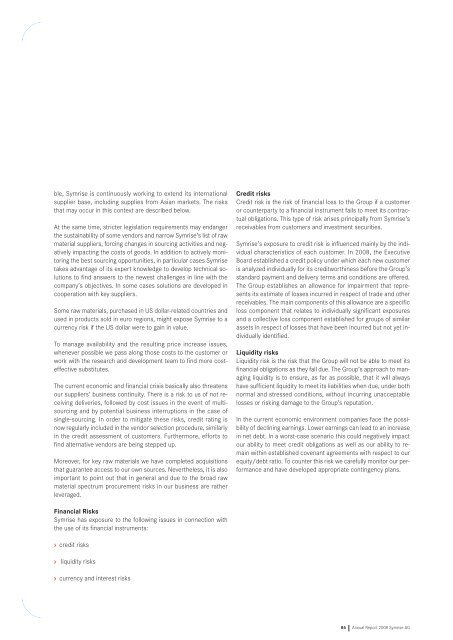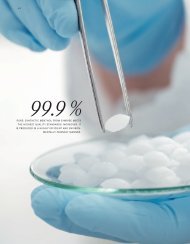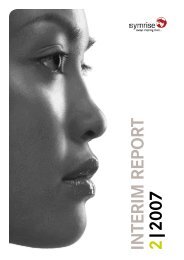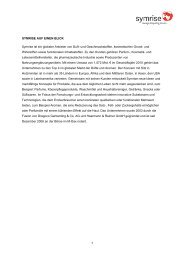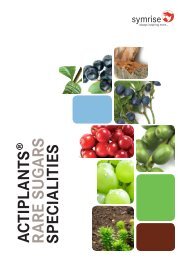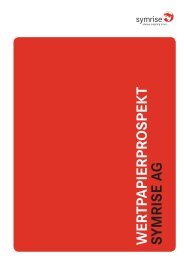THE NATURE OF OUR BUSINESS – STABLE GROWTH - Symrise
THE NATURE OF OUR BUSINESS – STABLE GROWTH - Symrise
THE NATURE OF OUR BUSINESS – STABLE GROWTH - Symrise
You also want an ePaper? Increase the reach of your titles
YUMPU automatically turns print PDFs into web optimized ePapers that Google loves.
le, <strong>Symrise</strong> is continuously working to extend its international<br />
supplier base, including supplies from Asian markets. The risks<br />
that may occur in this context are described below.<br />
At the same time, stricter legislation requirements may endanger<br />
the sustainability of some vendors and narrow <strong>Symrise</strong>’s list of raw<br />
material suppliers, forcing changes in sourcing activities and negatively<br />
impacting the costs of goods. In addition to actively monitoring<br />
the best sourcing opportunities, in particular cases <strong>Symrise</strong><br />
takes advantage of its expert knowledge to develop technical solutions<br />
to find answers to the newest challenges in line with the<br />
company’s objectives. In some cases solutions are developed in<br />
cooperation with key suppliers.<br />
Some raw materials, purchased in US dollar-related countries and<br />
used in products sold in euro regions, might expose <strong>Symrise</strong> to a<br />
currency risk if the US dollar were to gain in value.<br />
To manage availability and the resulting price increase issues,<br />
whenever possible we pass along those costs to the customer or<br />
work with the research and development team to find more costeffective<br />
substitutes.<br />
The current economic and financial crisis basically also threatens<br />
our suppliers’ business continuity. There is a risk to us of not receiving<br />
deliveries, followed by cost issues in the event of multisourcing<br />
and by potential business interruptions in the case of<br />
single-sourcing. In order to mitigate these risks, credit rating is<br />
now regularly included in the vendor selection procedure, similarly<br />
in the credit assessment of customers. Furthermore, efforts to<br />
find alternative vendors are being stepped up.<br />
Moreover, for key raw materials we have completed acquisitions<br />
that guarantee access to our own sources. Nevertheless, it is also<br />
important to point out that in general and due to the broad raw<br />
material spectrum procurement risks in our business are rather<br />
leveraged.<br />
Financial Risks<br />
<strong>Symrise</strong> has exposure to the following issues in connection with<br />
the use of its financial instruments:<br />
› credit risks<br />
› liquidity risks<br />
› currency and interest risks<br />
Credit risks<br />
Credit risk is the risk of financial loss to the Group if a customer<br />
or counterparty to a financial instrument fails to meet its contractual<br />
obligations. This type of risk arises principally from <strong>Symrise</strong>’s<br />
receivables from customers and investment securities.<br />
<strong>Symrise</strong>’s exposure to credit risk is influenced mainly by the individual<br />
characteristics of each customer. In 2008, the Executive<br />
Board established a credit policy under which each new customer<br />
is analyzed individually for its creditworthiness before the Group’s<br />
standard payment and delivery terms and conditions are offered.<br />
The Group establishes an allowance for impairment that represents<br />
its estimate of losses incurred in respect of trade and other<br />
receivables. The main components of this allowance are a specific<br />
loss component that relates to individually significant exposures<br />
and a collective loss component established for groups of similar<br />
assets in respect of losses that have been incurred but not yet individually<br />
identified.<br />
Liquidity risks<br />
Liquidity risk is the risk that the Group will not be able to meet its<br />
financial obligations as they fall due. The Group’s approach to managing<br />
liquidity is to ensure, as far as possible, that it will always<br />
have sufficient liquidity to meet its liabilities when due, under both<br />
normal and stressed conditions, without incurring unacceptable<br />
losses or risking damage to the Group’s reputation.<br />
In the current economic environment companies face the possibility<br />
of declining earnings. Lower earnings can lead to an increase<br />
in net debt. In a worst-case scenario this could negatively impact<br />
our ability to meet credit obligations as well as our ability to remain<br />
within established covenant agreements with respect to our<br />
equity/debt ratio. To counter this risk we carefully monitor our performance<br />
and have developed appropriate contingency plans.<br />
86 Annual Report 2008 <strong>Symrise</strong> AG


